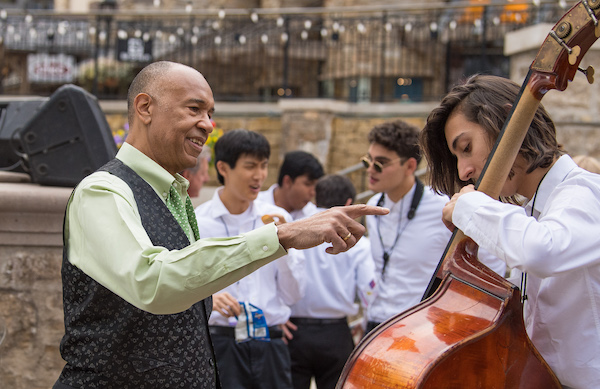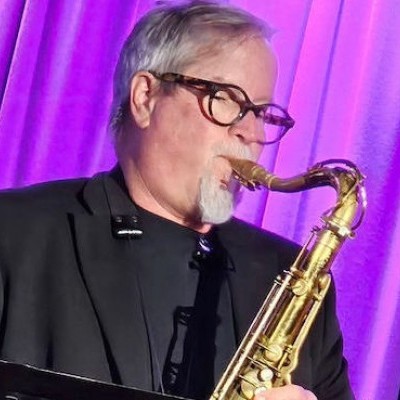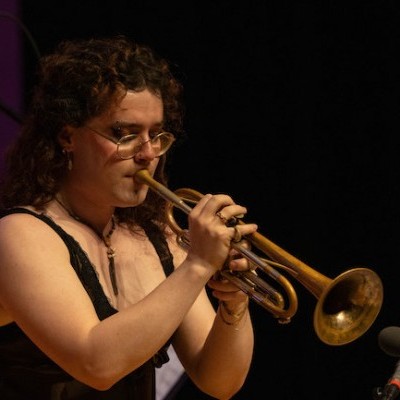Oct 28, 2025 10:47 AM
In Memoriam: Jack DeJohnette, 1942–2025
Jack DeJohnette, a bold and resourceful drummer and NEA Jazz Master who forged a unique vocabulary on the kit over his…

Bassist John Clayton (left) has helmed the Vail Jazz Workshop since its inception in 1996.
(Photo: Jack Affleck)After bassist John Clayton played the first Vail Jazz Party over Labor Day Weekend in 1995, he asked festival founder Howard Stone what he planned to do for a follow-up.
“Howard said he wanted to add an educational component,” recalled Clayton. “I told him I loved the idea and I wrote him a check. ‘I want to be the first one to contribute,’ I said. ‘And if you need me in any way, just give me a call.’”
So began the Vail Jazz Workshop in 1996, with Clayton at the helm. Over its 25 years, the workshop, which takes place the week before the Vail Jazz Party, has mentored 298 high school students; its alums include familiar players such as pianist Robert Glasper, trumpeter Ambrose Akinmusire, saxophonists Tia Fuller and Grace Kelly, and drummer Obed Calvaire, as well as rising stars like pianists James Francies and Justin Kauflin, and bassist David Wong.
The Vail Jazz Workshop (scheduled for Aug. 29–Sept. 7) is distinctive for numerous reasons, but most salient is its unusually low student-teacher ratio. Each year, six jazz masters tutor 12 students, who are chosen from a pool of more than 150 applicants.
The founding faculty was the Clayton Brothers sextet. Over the years, the teaching staff has remained relatively stable, with three original members returning in 2020: Clayton, trumpeter Terell Stafford and pianist Bill Cunliffe. The other teachers this year are drummer Lewis Nash, saxophonist Dick Oatts and trombonist Wycliffe Gordon. The faculty sextet is mirrored twice by the student body, which consists of two players on each instrument practiced by the teachers. Students receive daily, one-on-one private lessons from their mentors.
“Herlin Riley was the [drum] instructor the year I attended,” recalled Calvaire, who attended in 1998 and went on to tour with Clayton before joining the SFJAZZ Collective. “It is one of the best things that ever happened to me. Herlin helped my playing, my musical decisions, my whole concept of grooving, and my view of how I played. By the time you left, you were a brand-new musician.”
Not only that, you had a personal window to a career.
“Up until a year ago, I was playing with John,” Calvaire said, “so just being a part of that group in that camp—I don’t think I would have had those opportunities otherwise.”
Another key attraction at Vail is that the students are invited to perform at the festival with their mentors, which presents a challenging opportunity, but also allows audiences to get a glimpse of the next generation of jazz stars.
“That’s one of the biggest thrills you can imagine for the students,” Clayton said. “They’re no longer in a room with six instructors; instead, they’ve having to play for an audience. The whole week leads toward that.”
During that week, students are provided no written music: Everything is done by ear. Instructors bring or write new tunes on the spot and arrangements are made that week. This means every student has to memorize every note—except for their solos, of course.
“Every one of these students gets plenty of practice reading music in school,” Clayton said. “They have private lessons, band directors; they play in ensembles. But how much opportunity do they have to learn a tune simply by listening to it? And then, going further, not only learning the song, but really learning an involved arrangement, where they’re playing the middle parts, the harmony parts? This allows us to really go deep.”
The annual operating cost for the Vail workshop is about $120,000, but thanks to Stone’s fundraising acumen and the generosity of the Vail community, very little of that budget comes from tuition. Students who cannot afford it pay nothing for the workshop, which includes room and board provided by families in Vail. Stone and Clayton work hard to get the word out to band directors around the country whose student bodies include low-income kids, musicians of color and young women, which is evident from their alumni list.
That said, auditions are blind, so there’s no predicting each year’s ethnic or gender mix. If there happens to be a tie between two applicants, Clayton explained that the faculty might “lean toward the student of color or a female,” to promote diversity within the group. He added, “We also try to let students [who don’t get in] know that we were impressed with their level [of talent] and want them to audition again. Also, if one student happens to be a senior, then we’ll probably choose that student because they won’t have a second chance.”
Students who do get in often have no idea how hard they will be asked to work. A typical workshop day can last as long as 14 hours. After breakfast with their host families, students are taken to the Marriott Hotel, where the morning starts with a lecture by one of the instructors about their own challenges and careers, which gives students a feel for their teachers as real people, not just professionals. Clayton himself is inspirational in this respect, bringing real life experience to his “raps,” as he calls them.
“We discuss how we talk to each other as human beings and bandmates—about not being afraid to dig deep and express yourself through the music,” Clayton said. “From there, we take a quick break, and then they start practicing and rehearsing, learning all that music with no written-down notes. Then they have private lessons and then there are more playing sessions, till as late as 10 or 11 p.m. So, not only are we trying to give them a bit of insight into our lives, but also we want them to know what it feels like to be playing music hour after hour after hour, for the whole day and night. Because that’s part of the experience. We’ve all had those kinds of days, playing one-nighters, being on the road.”

Jack DeJohnette boasted a musical resume that was as long as it was fearsome.
Oct 28, 2025 10:47 AM
Jack DeJohnette, a bold and resourceful drummer and NEA Jazz Master who forged a unique vocabulary on the kit over his…

“I’ve told students, ‘I don’t mind if you use AI for this or that project,’” says MIT’s Pascal Le Boeuf. “‘But you need to tell me.’”
Sep 18, 2025 11:14 AM
A standard joke when it comes to discussing artificial intelligence, or AI, is that it’s developing so rapidly that…

Chuck Manning Works for NASA … and plays jazz.
Sep 18, 2025 11:23 AM
Congratulations! After years of study, you’ve earned your degree in jazz performance. But let’s face it: Making a…

Always a sharp dresser, Farnsworth wears a pocket square given to him by trumpeter Art Farmer. “You need to look good if you want to hang around me,” Farmer told him.
Sep 23, 2025 11:12 AM
When he was 12 years old, the hard-swinging veteran drummer Joe Farnsworth had a fateful encounter with his idol Max…

“Make time and energy to meet people and make friends,” suggests Millie Ahearn, a student at DePaul University.
Sep 18, 2025 11:32 AM
For many students, the transition into a collegiate jazz program can feel overwhelming — new peers, unfamiliar…